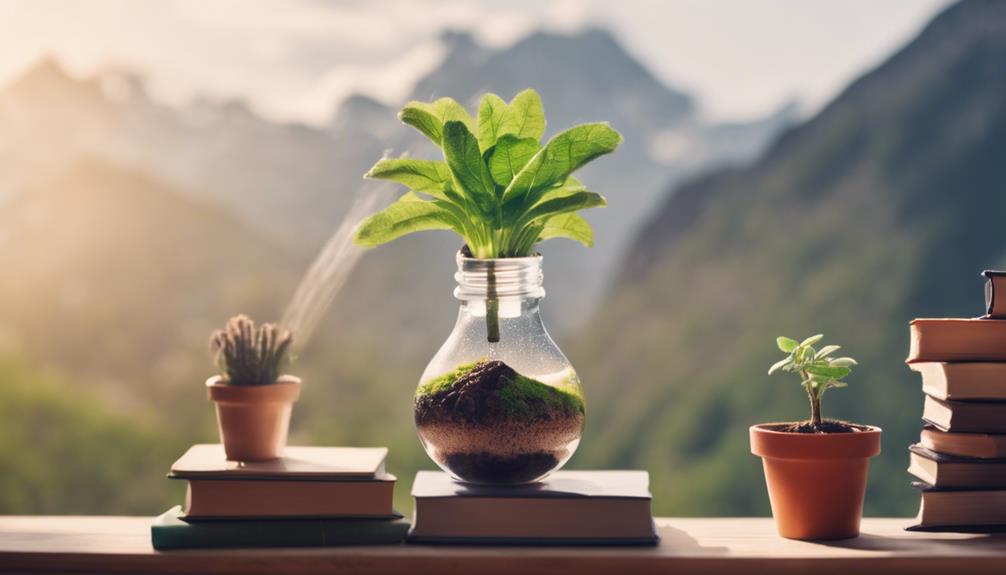To make Thanksgiving more meaningful, try quick gratitude rituals like journaling a few things you’re thankful for each day or keeping a gratitude jar where you add positive notes effortlessly. These simple practices only take a few minutes but help you focus on the good moments, shifting your mindset from scarcity to abundance. Incorporating these rituals into your routine can deepen your appreciation and joy—discover more easy ways to enrich your celebration.
Key Takeaways
- Incorporate a daily 3-minute gratitude journaling session to focus on simple, positive moments.
- Use a gratitude jar by writing down and collecting small thankfulness notes throughout the day.
- Share quick gratitude reflections with family or friends during meal times to foster connection.
- Take brief pauses during busy moments to acknowledge and appreciate something in the present.
- Set a reminder to practice gratitude regularly, turning appreciation into a simple, daily habit.

Practicing gratitude doesn’t have to take up hours of your day; in fact, quick gratitude rituals can seamlessly fit into your busy schedule. These simple acts help you pause, reflect, and connect with the positive moments in your life, making Thanksgiving feel even more meaningful. One effective method is mindful journaling. You don’t need to dedicate hours to it—just set aside a few minutes each morning or evening. Grab a notebook or a dedicated gratitude journal, and write down three things you’re thankful for. It could be as simple as a warm cup of coffee, a kind word from a friend, or a moment of peace during a hectic day. The act of putting pen to paper helps you focus on the present and cultivates a mindset of appreciation. Over time, you’ll notice your outlook shifting, with more gratitude becoming second nature. Incorporating positive psychology principles can enhance the effectiveness of your gratitude practices and deepen your sense of fulfillment.
Another quick ritual that fits easily into your routine is creating a gratitude jar. Keep a small jar or container somewhere visible—on your kitchen counter, desk, or bedside table. Whenever something positive happens during your day, write it down on a small piece of paper and drop it into the jar. This could be a compliment you received, a beautiful sunset, or even a personal achievement. The key is to make it effortless: don’t overthink it or wait for the perfect moment. Just jot down what made you smile or feel grateful, and add it to the jar. When Thanksgiving arrives, you can take a few minutes to read through all the notes. Reflecting on these moments not only boosts your mood but also reminds you of the abundance in your life, even during challenging times.
Both mindful journaling and gratitude jars are powerful, yet simple tools that turn gratitude into a quick, daily habit. These rituals encourage you to focus on what’s good, helping you shift your perspective from what’s lacking to what’s plentiful. Plus, they don’t require a lot of time or effort—just a few moments each day. Incorporating these into your routine can transform your Thanksgiving experience, making it richer and more heartfelt. As you practice, you’ll find gratitude becoming an automatic part of your day, helping you savor the season and the many blessings in your life. These quick rituals serve as gentle reminders that appreciating the small things can lead to a more joyful and meaningful holiday.
Frequently Asked Questions
How Can Kids Participate in Gratitude Rituals Effectively?
You can encourage kids’ gratitude by involving them in simple family participation activities. Have them share what they’re thankful for during dinner or create a gratitude jar where they add notes throughout the day. Let them draw pictures of things they appreciate or lead a short gratitude circle. These quick rituals make kids feel valued and help them understand the importance of family participation in celebrating gratitude.
Are There Quick Gratitude Rituals Suitable for Small Gatherings?
Imagine you’re in the time of the Renaissance, and quick gratitude rituals are your secret weapon. You can lead your small gathering with brief gratitude journaling sessions, where everyone writes down what they’re thankful for. Or try quick appreciation exercises, like sharing one thing you appreciate about each person present. These simple, meaningful activities effectively foster connection and gratitude without taking up much time, making your celebration more heartfelt and memorable.
Can These Rituals Be Adapted for Non-Traditional Families?
Yes, you can adapt gratitude rituals for non-traditional families by incorporating interfaith practices and cultural adaptations. You might, for example, share blessings from different traditions or create a gratitude circle that respects everyone’s beliefs and backgrounds. By blending elements from various cultures and faiths, you foster inclusivity and deepen connections, making your gathering more meaningful and respectful of each person’s unique perspective.
What Are Some Inexpensive Gratitude Activities to Try?
Did you know that gratitude journaling can boost your happiness? To try inexpensive gratitude activities, start a gratitude journal where you jot down three things you’re thankful for each day. You can also write appreciation notes to friends or family, expressing your gratitude. Both activities cost little to nothing and help you focus on the positive, making your Thanksgiving more meaningful and uplifting.
How Do I Encourage Reluctant Family Members to Join?
To encourage reluctant family members to join, try family persuasion with gentle engagement strategies. You can start by sharing your own gratitude openly, making it feel safe for others to follow. Keep activities simple and fun, emphasizing connection over perfection. Respect their comfort levels and avoid pressure. By creating a warm, inclusive atmosphere, you’ll naturally inspire participation and foster a deeper sense of gratitude among everyone.
Conclusion
By incorporating quick gratitude rituals into your day, you deepen your appreciation and make every moment more meaningful. For example, imagine taking a minute each morning to silently thank someone who helped you recently—this simple act can boost your mood and strengthen relationships. When you make gratitude a daily habit, even small gestures can create lasting positive change. So, start today, and watch how your perspective shifts, enriching your Thanksgiving and beyond.









